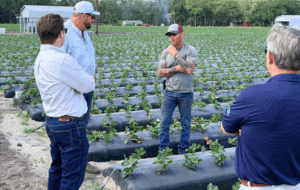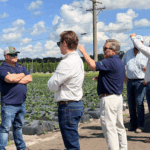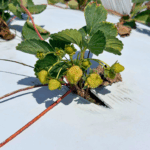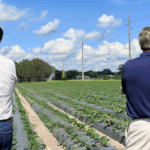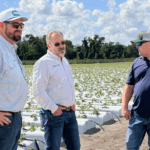Field Notes from E.W. Simmons & Fancy Farms
Nutrition, yield planning, and insights from our October Plant City field visits.
Strawberry season in Florida moves fast. Decisions made before the first bloom, bed construction, mulch selection, transplant timing, irrigation layout, and early nutrition shape plant vigor, fruit quality, and yield potential. This month, our team visited E.W. Simmons Farms and Fancy Farms in Plant City to compare notes on what’s working as fields head into the cool-night, bright-day window.
E.W. Simmons Farms: Nutrition Programs that Protect Yield
Key theme: Early, precise nutrition creates a foundation for consistent bloom and steady pick volume.
- Uniform starts: Even plant size and strong roots make fertigation more predictable and reduce early stall.
- Early feeding matters: Low, frequent fertigation supports canopy growth and flower initiation without excess vegetative push.
- Tissue + petiole checks: Regular sampling prevents silent deficiencies (K, Ca, Mg, Fe, Mn, B) that can lead to soft fruit or uneven sets.
- Stress buffering: Biostimulant support during cold snaps and cloudy periods helps maintain continuity in flowering and sizing.
- Quality + pack-out: Potassium and calcium management tie directly to firmness, shelf life, and reduced bruising.
Fast takeaways: Start balanced (N-P-K) and shift toward K and Ca as flowering ramps. Monitor EC/pH in drip. Schedule tissue tests every 10–14 days through early pick.
“You can’t out-pick a nutrition gap. Catch it early and you harvest the difference all season.”
Fancy Farms: White Plastic vs. Black Plastic—What Changes?
Key theme: Mulch color is a microclimate lever that affects soil temperature, moisture, and earliness.
- White plastic: Reflects heat, keeps beds cooler during warm fall spells; supports transplant comfort and early flower formation.
- Black plastic: Absorbs heat, warms beds faster for earlier planting after cool fronts; may require tighter irrigation during hot snaps.
- Moisture dynamics: White moderates surface temps; black may drive quicker dry-downs—adjust irrigation accordingly.
Decision guide: If Sep–Oct run warm, favor white. If a cooler fall is forecast and earliness is essential, consider black. Match fertigation and irrigation to the intenral thermal behavior.
Pre-Season Checklist (Plant City Edition)
- Verify crown height, edge seal, and drip placement before transplants arrive.
- Drip audit: pressure, flow, uniformity, filter condition; log EC/pH head and tail.
- Starter fertigation: low-dose, frequent for first 2–3 weeks post-transplant.
- Sampling cadence: set tissue sample dates; align with spray/irrigation schedules.
- Frost readiness: inspect row covers, repair tears, label pallets, rehearse deployment.
- Records: bed temp (probe), dawn air temps, soil moisture to inform fertigation tweaks.
What This Means for Yield
- Stronger early roots → uniform canopy → predictable flowering
- Balanced K/Ca late → firmer fruit and better pack-out
- Right mulch for the year → fewer stress swings → steadier picks


